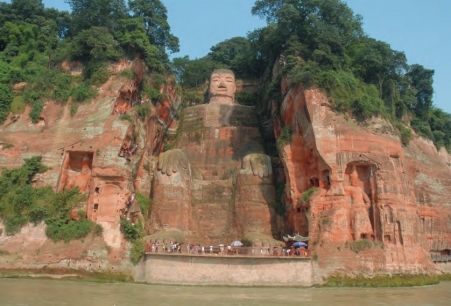Like ecocriticism in literary studies,
Sites in Sichuan illuminate key aspects of
To fully engage the ecological approach to the cave temples of Sichuan, my book is organized into three parts (each consisting of two chapters and each dealing with a central aspect of the geography and climate of the region: rivers, rainfall, mountains). While at CASVA, I have worked on the first part, which investigates the decisive role that the Yangzi River and its tributaries assumed in shaping the distribution and function of Buddhist cave temples and other religious establishments in Sichuan. The seventy-meter-tall Maitreya Buddha at Leshan, the main subject of my CASVA colloquium, is the focus of the first chapter of the book, in which I account for the rise of monumental statuary in the eighth and ninth centuries in relation to a prehistory of monumental undertakings along the Min River as marked by water-control systems and cliffside tombs. As a thematic counterpart to the creation of the Leshan Buddha, the second chapter examines the later reception of Sichuan’s riverscapes through a discussion of two painted handscrolls from the twelfth and thirteenth centuries in the Freer Gallery of Art. Significantly, one scroll contains visual records of Leshan and other temple complexes nearby, which have allowed me to explore changes in the sacred and cultural geography of Sichuan during the Song period and afterward.
Members' Research Report Archive
Between Culture and Nature: Cave Temples of Sichuan
Sonya S. Lee, University of Southern California
Paul Mellon Senior Fellow, 2011–2012
Cave temples are a unique architectural form that changes a natural formation, such as a mountain cliff face or a large boulder, into a place for religious activities through the installation of pictorial images and other artifacts. The relative distance of these structures from urban centers and the use of durable material for their construction and decoration have allowed them to endure for centuries. As hybrid spaces that are at once natural and artificial, cave temples are an ideal means by which to explore the complex relationship between art and the environment. This project focuses on specimens from the southwestern province of Sichuan (including the Chongqing municipality) in China. The choice of subject highlights a region rich in its engagement with nature since antiquity, as evident in the local history of artistic practices, land use, social institutions, politics, religious beliefs, and technological development. It also supplies a well-defined body of materials and historical conditions for developing an earth-centered approach to art-historical issues, which I term “eco–art history.”

The Maitreya Buddha, early eighth–early ninth century, Leshan, Sichuan. Author photograph